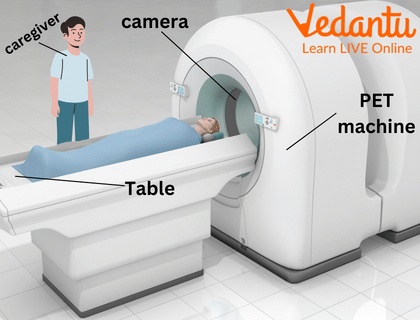




What are Beta Rays?
Beta particles are high energy, fast electrons (-) or positrons (+) released from the nucleus by some radioactive elements during a kind of radioactive decay known as beta-decay. Normally, beta-decay happens in nucleus with too many neutrons to achieve stability.

Beta Particle
Uses of Beta Rays
These particles have certain helpful qualities due to their moderate penetrating power. As a result, beta particles are used in a wide variety of applications. Tracers and material thickness monitoring are both done with beta radiation.
Tracers are radioactive substances that doctors may use for medical imaging. Certain chemicals concentrate in certain injured or diseased regions of the body, and radiation concentrates alongside them. Radiation detectors positioned outside the body detect the radiation emitted and create an image of the inside of the body using computers.
Radiation is used to measure the thickness of materials like paper, plastic, and aluminium. The more radiation that is absorbed, the less radiation that reaches the detector.

Uses of Beta Gamma and Alpha Rays and Its Effectiveness
Application of Beta Rays
Beta particles can be used to treat diseases such as eye and bone cancer, as well as tracers. The most frequent substance utilised to create beta particles is strontium-90.
Beta particles are also employed in quality control to measure the thickness of an item, such as paper, as it passes through a roller system. While travelling through the product, some of the beta radiation is absorbed. If the product is too thick or too thin, a different amount of radiation will be absorbed.
A computer programme that monitors the quality of the created paper will then move the rollers to change the end product's thickness.
Uses of Beta Radiation in Industry
Positron emission tomography also makes use of the beta-plus (or positron) decay of a radioactive tracer (PET scan).

PET Scan
In industry, radiation is used in detectors to monitor and manage the thickness of materials such as paper, plastic, and aluminium. The more radiation that is absorbed, the less radiation that reaches the detector. It then sends signals to the machinery that regulates the material's thickness.
Doctors also use radioactive substances called "tracers" for imaging purposes. Tracers and material thickness monitoring are both done with beta radiation.

Use of Beta Radiation in Industry
Here, the radioactive source is the beta rays
Uses of Beta Radiation in Medicine
Beta particles can be used to treat diseases such as eye and bone cancer, as well as tracers.
Beta-emitting radiopharmaceuticals (substances used to identify or treat certain medical issues or disorders), such as radioimmunotherapy and bone-seeking radiopharmaceutical therapy, are finding broader applications in cancer treatment. Beta-emitting radioisotopes have also been widely employed in vascular brachytherapy (the use of radioactive implants to treat cancer, particularly prostate cancer, directly within the tissue) and other forms of brachytherapy.
Beta Radiation Used in Daily Life
The manufacturing industries use beta decay of elements for a variety of applications.
One of the most visible applications of beta decay in real life can be found in medicine. A variety of diagnostic and therapeutic devices used in hospitals and biology laboratories rely on the beta decay of radioactive elements such as uranium, thorium, and others.
The use of beta decay in the decomposition of a deceased organism's body is plainly recognised, as the carbon element, C-14, begins to decay and is changed into nitrogen, N-14.
Beta-decay is frequently employed in surgical procedures. For example, in the case of glaucoma surgery, beta decay or beta radiation are frequently preferred.

Surgery

Decomposition of the Body
Solved Examples
1. What effect do beta rays have on humans?
Ans: Beta particles can enter the skin and cause radiation damage, such as skin burns. Beta emitters, like alpha emitters, are most dangerous when breathed, eaten, or absorbed into the bloodstream through wounds.
2. What is the method for detecting beta radiation?
Ans: Scintillation counters are capable of detecting alpha, beta, and gamma radiation, as well as neutrons.
3. Where can you find beta particles?
Ans: The nucleus of the atom generates beta radiation. A neutron within the nucleus is transformed into a proton and an electron, and the electron is expelled in beta emission.
Conclusion
Although many investigations have been conducted without the use of beta rays, a few categories are required in the medical area, industry, cancer therapy, bone and skin disorders, and so on. These radiation existed many years ago, but there were no scholars who practically brought them, and they were used, but not in the way that they are currently employed. Because of the existence of these rays, technology is progressing from complicated to simple. These may be used in different ways in the near future.
FAQs on Uses of Beta Rays
1. Who created beta particles?
Ernest Rutherford established in 1899 that there were at least two kinds of radiation: alpha radiation and beta radiation. He noticed that radioactive preparations caused gas production.
2. How fast does a beta particle move?
The velocity of a beta particle is determined by its energy, and it can travel at speeds ranging from zero to nearly the speed of light ($2.9 x 10^8$ m/sec).
3. What are the types of beta decay?
There are two beta decay types: beta minus (β–) and beta plus (β+).
4. How are beta rays avoided?
In air, beta particles can travel significant distances, but they can be decreased or blocked by a layer of clothing, a thin sheet of plastic, or a thin sheet of aluminium foil. To stop the more intense gamma rays, many feet of concrete or a thin covering of a few inches of lead may be necessary.
5. What is an illustration of beta radiation?
Strontium 90, technetium 99, caesium-137, carbon-14, sulphur-35, and tritium are examples of common beta emitters. Although beta radiation has greater penetration than alpha radiation, it would still struggle to penetrate our clothing. It has enough energy to infiltrate our skin but not enough to travel through it.









